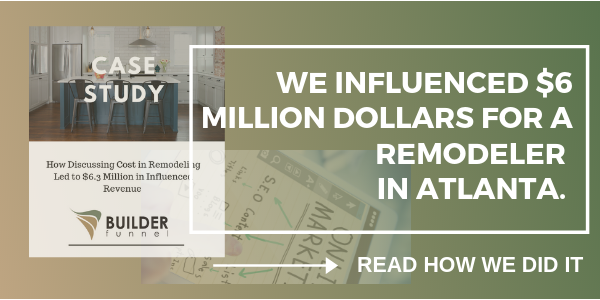2 min read
Why Your Current Marketing Budget Won’t Sell More Homes (And What You Can Do About It)
By: Spencer Powell on Nov. 27, 2018

 Smart homebuilders know the important role good marketing plays in the success of their business. But when it comes to setting their marketing budget (not their favorite activity in the first place) they scratch their heads and think: “I allocated X last year so I’ll allocate X+10% this year.” That kind of thinking, however, isn’t going to generate a 10% increase in sales.
Smart homebuilders know the important role good marketing plays in the success of their business. But when it comes to setting their marketing budget (not their favorite activity in the first place) they scratch their heads and think: “I allocated X last year so I’ll allocate X+10% this year.” That kind of thinking, however, isn’t going to generate a 10% increase in sales.
While having a realistic marketing budget amount is important, it’s really not just about how much you spend on marketing—it’s about how you do your marketing. That’s the real reason your current marketing budget won’t help you sell more houses. It’s not about spending more—it’s about spending smarter. It’s about being strategic with your marketing plans (and budget).
It’s easy for homebuilders (and other businesses) to get caught up in chasing after the newest, coolest, marketing trend. It’s kind of the “BSO (Bright Shiny Object) Syndrome” that seems to suggest that if something is new and interesting it must be good. It’s good to be open to new ideas and new methods, but what you really want to be focused on is not the tools or the platforms—but on your potential customers. What are they after?
First of all, it’s important to recognize that potential clients aren’t sitting in their homes desperately waiting for you message. Even someone who is drop dead serious about building a new home isn’t saying: “Gee, I hope ACME builders sends me some information soon!”
What are your prospects doing? They're actively searching the Internet to educate themselves about ideas and options. They’re gathering information about products, trends, and who offers what it is that they want. They aren’t waiting for you to offer them information. They’re already looking for it on their own. That’s the essence of Inbound Marketing: Engaging prospects with the information they’re after and pulling them in—rather than trying to push a sales pitch on someone who hasn’t asked for it. (Here’s a helpful free eBook that provides a great overview of the inbound marketing process for builders and remodelers)
The gurus at independent market research company Forrester have data that indicates a buyer’s journey is 90 percent complete by the time he or she engages with sales. If you’re relying on your sales team to reach new customers, you’re way behind the curve. You’ve got to get way in front of the sales moment if you want to influence buying decisions.
Instead of focusing on new technologies and platforms, what you really need to pay attention to is:
- Who are my ideal clients?
- What kind of information are they really after?
- How can I make that information easily available to them?
- How can I make contact with the right clients—and stay in touch?
Successful home building marketing isn’t about “one-and-done” efforts. They key is thoughtful and consistent messaging over time. Once you think through those things, you can figure out a consistent plan that you’ll execute regularly. When you figure that out, you can also calculate how much it will cost you to do that.
The real reason your current budget won’t sell more homes isn’t because you’re not spending enough—it’s because you’re not spending your money on the right things—consistent, strategic marketing efforts that give clients what they’re after and generate qualified leads for your sales team to follow up on.



